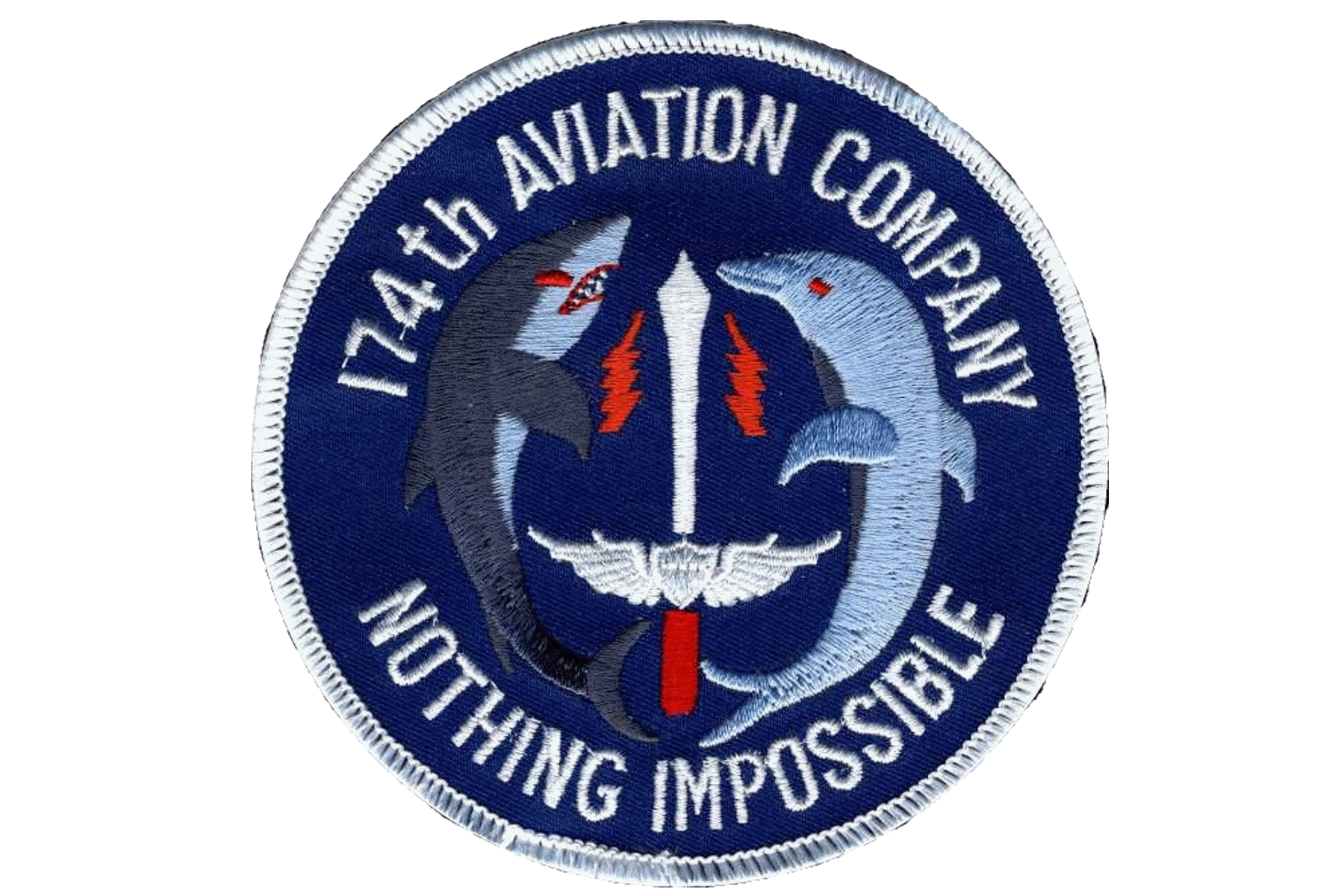
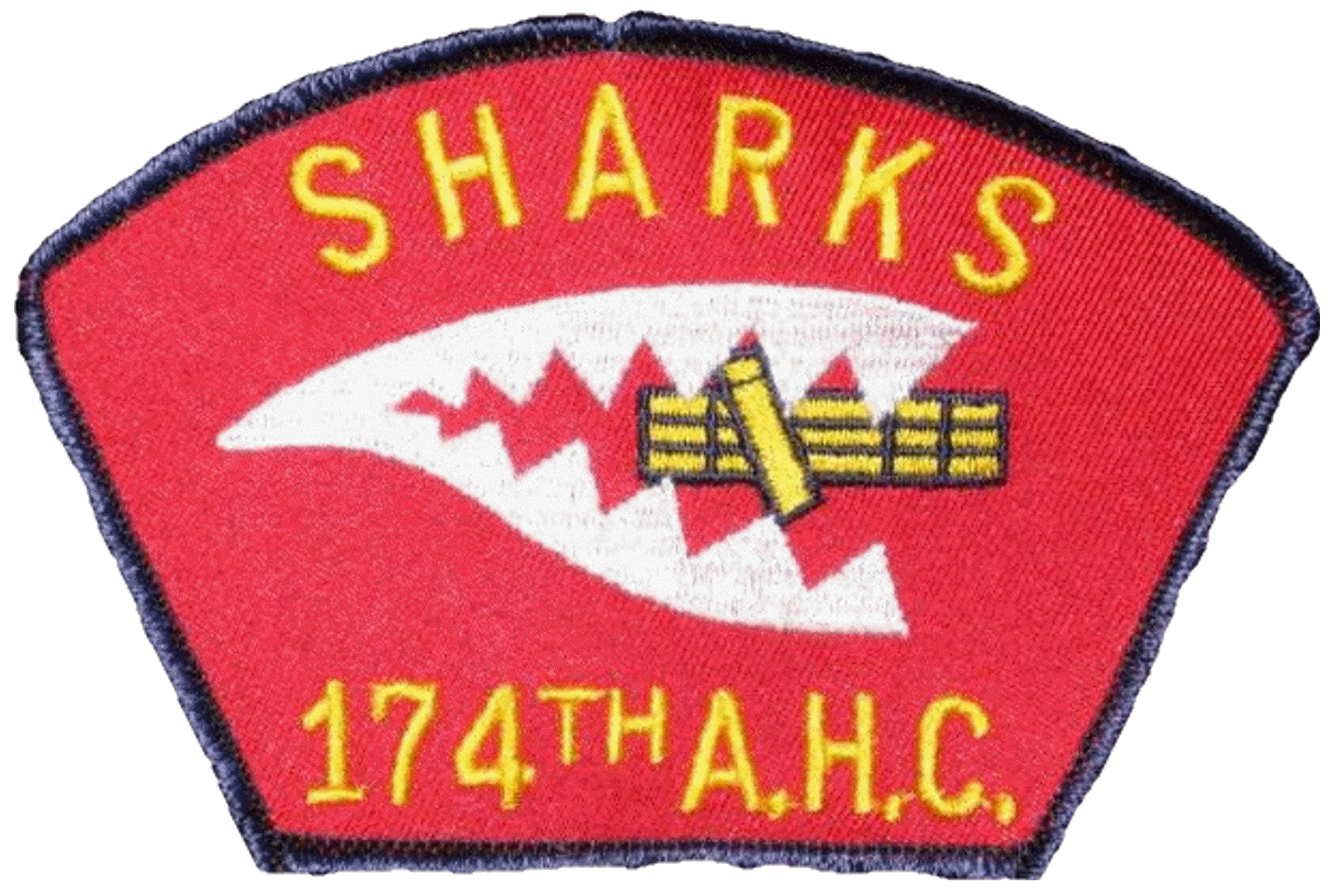
174th Assault
Helicopter Company
DOLPHINS & SHARKS
DOLPHIN NOSE ART
The 174th Dolphins, the "slicks," adopted the above nose-art logo in mid-1967 that became a standard for several years. While
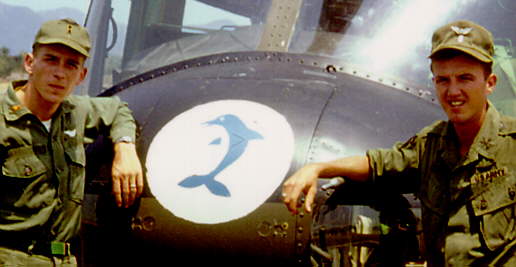 there were a few individualized drawings used for nose-art on Dolphins, both before and after the ones depicted here, none were known to have been used on more than one aircraft at a time. The photo at the right was drawn on one of the Dolphins in early 1967, but was a one-only drawing (click HERE for more information on this photo). The logo that did become widely used depicted a caricature of a dolphin standing on its tail. It was drawn on the nose of the helicopter on the avionics door cover, with teeth showing, wearing a flight helmet, with a red scarf around its neck. (Note: Later a red scarf was used to indicate Dolphins from the 2nd Flight Platoon and a yellow scarf was used to indicate 1st Flight Platoon.) An M-60 machine-gun was on top of the helmet. The dolphin had arms, and in its right gloved hand it was holding a cyclic. In the left hand it held a collective. Those were the normal flight controls held by the pilots while flying.
there were a few individualized drawings used for nose-art on Dolphins, both before and after the ones depicted here, none were known to have been used on more than one aircraft at a time. The photo at the right was drawn on one of the Dolphins in early 1967, but was a one-only drawing (click HERE for more information on this photo). The logo that did become widely used depicted a caricature of a dolphin standing on its tail. It was drawn on the nose of the helicopter on the avionics door cover, with teeth showing, wearing a flight helmet, with a red scarf around its neck. (Note: Later a red scarf was used to indicate Dolphins from the 2nd Flight Platoon and a yellow scarf was used to indicate 1st Flight Platoon.) An M-60 machine-gun was on top of the helmet. The dolphin had arms, and in its right gloved hand it was holding a cyclic. In the left hand it held a collective. Those were the normal flight controls held by the pilots while flying.
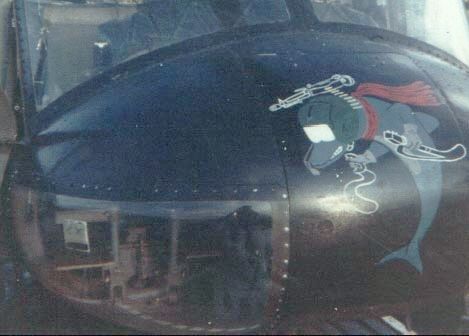 The top photo and the photo to the left show the original nose-art of this type, designed and painted on Dolphin 66-16235 by WO1 Richard Machina in July or August 1967. Dolphin 235 was a brand new UH-1D that had just arrived in the Company, and four of the first five photos (with the exception of the early '67 photo) are of the same aircraft.
The top photo and the photo to the left show the original nose-art of this type, designed and painted on Dolphin 66-16235 by WO1 Richard Machina in July or August 1967. Dolphin 235 was a brand new UH-1D that had just arrived in the Company, and four of the first five photos (with the exception of the early '67 photo) are of the same aircraft.
WO1 Jim McDaniel (webmaster) and Machina were friends and platoon-mates in helicopter flight school at both Ft. Wolters, Texas and Ft. Rucker, Alabama. Machina only drew one of these logos before being severely wounded and medivaced back to the States in September 1967. He was shot up while flying in this very helicopter with McDaniel on a large multi-battalion combat assault supporting the 101st Airborne Division northwest of Chu Lai, in the vicinity of the Que Son valley. It was McDaniel's first flight as an aircraft commander and was to have been Machina's
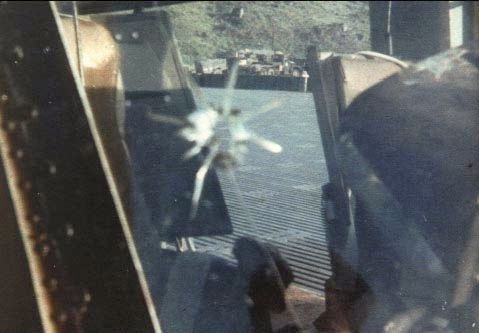 last flight as a "peter pilot" (co-pilot), before he too became an aircraft commander. Both McDaniel and Machina had passed their Aircraft Commander checkrides the day before this flight. While at about only 50 feet altitude on approach to an LZ "way out in the boonies," the helicopter took multiple hits in the fuselage and cockpit area from automatic weapons fire when it flew directly over the VC while on short final. Several armor-piercing rounds went completely through the aircraft body, including the fuel cells, exiting through the top of the aircraft. One round went through the windshield only inches from Machina. He was hit by another armor-piercing round that entered through the aircraft belly directly below his legs. The 3nd, 4rd, and 5th photos were taken of his aircraft soon after Machina was dropped off at the Chu Lai hospital medevac pad. Machina's design was copied and many of the later Dolphin helicopters had variations of this same caricature painted on them by other people, usually crew chiefs and gunners.
last flight as a "peter pilot" (co-pilot), before he too became an aircraft commander. Both McDaniel and Machina had passed their Aircraft Commander checkrides the day before this flight. While at about only 50 feet altitude on approach to an LZ "way out in the boonies," the helicopter took multiple hits in the fuselage and cockpit area from automatic weapons fire when it flew directly over the VC while on short final. Several armor-piercing rounds went completely through the aircraft body, including the fuel cells, exiting through the top of the aircraft. One round went through the windshield only inches from Machina. He was hit by another armor-piercing round that entered through the aircraft belly directly below his legs. The 3nd, 4rd, and 5th photos were taken of his aircraft soon after Machina was dropped off at the Chu Lai hospital medevac pad. Machina's design was copied and many of the later Dolphin helicopters had variations of this same caricature painted on them by other people, usually crew chiefs and gunners.
The follow-on
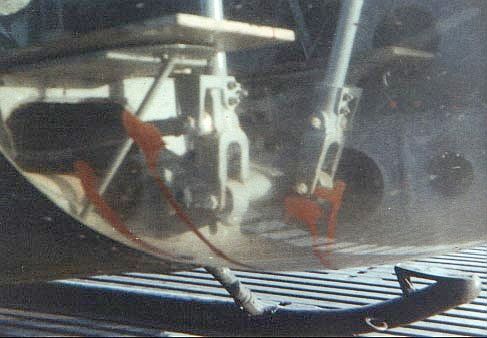 Dolphin's nose-art varied greatly, but all maintained the same basic look and theme. This particular helicopter crashed within a month or so after Machina was medivaced, when another pilot had a tail rotor strike resupplying a rocky hilltop observation post at night in a rain storm, causing the tail rotor to depart the rest of the aircraft. After the tail rotor failed, the helicopter began to spin out of control on the rocky hilltop until the main rotor also contacted a boulder, causing it to separate from the aircraft as well. Minus both its rotors, the helicopter then rolled partially down the hill. The aircraft was destroyed, but the nose avionics door cover (with the nose art) was saved. (Click HERE to see a photo of Dolphin after the crash.)
Dolphin's nose-art varied greatly, but all maintained the same basic look and theme. This particular helicopter crashed within a month or so after Machina was medivaced, when another pilot had a tail rotor strike resupplying a rocky hilltop observation post at night in a rain storm, causing the tail rotor to depart the rest of the aircraft. After the tail rotor failed, the helicopter began to spin out of control on the rocky hilltop until the main rotor also contacted a boulder, causing it to separate from the aircraft as well. Minus both its rotors, the helicopter then rolled partially down the hill. The aircraft was destroyed, but the nose avionics door cover (with the nose art) was saved. (Click HERE to see a photo of Dolphin after the crash.)
In the nose art below (artist C/E Ben Kennedy 1968), you can see the personal modifications some later artwork took. This was Dolphin 543 from the 1968-69 time period, flown by J.C. Pennington, and the Dolphin here is clearly a more blood-shot-eyed, war-hardened, experienced, and worldly Army Aviator-type Dolphin. He has released his collective stick hand and is instead holding a can of Schlitz. Lettered above the Dolphin, but barely visible because of the glare in this photo, was our call-to-arms, "When you're out of Schlitz, you're out of BEER!" Machina's basic Dolphin design, with personal modifications, was used well into 1969, but photos of the Dolphins in the late 1970-71 time period do not have the logo on the nose. The timing and reasoning for its removal is not known. Perhaps some "straight-laced" higher level commander didn't like the rather cavalier attitude of the 174th's Warrant Officer pilots and enlisted crews, and made the CO have them removed. If anyone reading this knows more detail of the demise of the Dolphin nose-art, please e-mail us at the homepage. (Upper photo by Jim McDaniel, 1967; 2nd photo by Billy Wood, 1967; middle three photos by Sam Davis,1967, lower photo by J.C. Pennington, 1969.)
=================================================
In November 2010, Ben Kennedy sent in the following e-mail message (slightly edited):
 Jim... You asked if anyone had info about the demise of Dolphin nose art, to drop you a line.
To the best of my knowledge, the nose art was standard thruout 1968, and most of the
helicopters had it painted on them. In November 1968, I was DEROS-shuffled to Duc-Pho
from the 176th (Chu-Lai). (Webmaster's note: DEROS = Date of Estimated Rotation [or Return]
OverSeas.) Others came to Duc-Pho with me, and Maj Brown talked some of
us into extending. We were all very near the end of our tours at the time. I extended, and as I
had been in the 2nd Plt of the 176th, he assigned me to 1st Plt of the 174th. A few of the
174th helicopters did not have nose art, and I ended up with one of them. There was a guy
that worked in the engine shop (tent) doing Hot End inspections. He had a few spare nose
doors in there, and painted the Dolphin nose art on them, and in turn, sold them to the
Crew Chiefs. He then got their old nose door when they replaced it with their new acquisition.
Early in 1969, he must have DEROS'ed (returned Stateside), as the art studio just went away. I did a little bit of
art for the guys, but the flight schedule got severe and there was little time to do anything
but sleep. I recall doing intermediate inspections on the flight line every other night (that
was a 25-hour inspection, every other night). Crew Chiefs and Gunners flew on medical waivers
all the time. The paperwork was handled routinely between the Flight Surgeon and Operations so
we didnít even have to go in for the medical after our first time. With the resident artist
from 1968 apparently now DEROS'ed, and no one else in the Maintenance Plt. doing the work,
attrition just caused the nose art to fade away. Some of us painted names on the nose (that
was something anyway), but there was little enough time for that. I painted "Satan" on 463
(my helicopter), and we had to take off with the paint still wet. I was concerned it would
get smeared across the nose, but the paint held. About the time the Dolphin nose art began
to vanish, the Sharks found an artist somewhere, who had the time and materials to paint the
large art displays on the compartment doors just ahead of the tail boom. Perhaps each Shark
Crew Chief did his own art work, I donít know. As far as I know, no authority issued any
orders against the nose art. They did, however, put a stop to the painting of flight helmets
in very late 1969. Those of us in the first platoon were ordered to paint our helmet black,
or olive drab, but no other color, or art allowed. This was near the end of my tour then, as
I had extended a second time while at Duc-Pho (finally going home after two years and six days, in January
1970). I donít know about anything that happened before or after my tour with the 174th,
but what I have written here, is just how I remember it. Thanks for your time, and I hope
this helps answer your question. --Ben Kennedy, Dolphin Crew Chief Nov 1968 to Jan 1970.
Jim... You asked if anyone had info about the demise of Dolphin nose art, to drop you a line.
To the best of my knowledge, the nose art was standard thruout 1968, and most of the
helicopters had it painted on them. In November 1968, I was DEROS-shuffled to Duc-Pho
from the 176th (Chu-Lai). (Webmaster's note: DEROS = Date of Estimated Rotation [or Return]
OverSeas.) Others came to Duc-Pho with me, and Maj Brown talked some of
us into extending. We were all very near the end of our tours at the time. I extended, and as I
had been in the 2nd Plt of the 176th, he assigned me to 1st Plt of the 174th. A few of the
174th helicopters did not have nose art, and I ended up with one of them. There was a guy
that worked in the engine shop (tent) doing Hot End inspections. He had a few spare nose
doors in there, and painted the Dolphin nose art on them, and in turn, sold them to the
Crew Chiefs. He then got their old nose door when they replaced it with their new acquisition.
Early in 1969, he must have DEROS'ed (returned Stateside), as the art studio just went away. I did a little bit of
art for the guys, but the flight schedule got severe and there was little time to do anything
but sleep. I recall doing intermediate inspections on the flight line every other night (that
was a 25-hour inspection, every other night). Crew Chiefs and Gunners flew on medical waivers
all the time. The paperwork was handled routinely between the Flight Surgeon and Operations so
we didnít even have to go in for the medical after our first time. With the resident artist
from 1968 apparently now DEROS'ed, and no one else in the Maintenance Plt. doing the work,
attrition just caused the nose art to fade away. Some of us painted names on the nose (that
was something anyway), but there was little enough time for that. I painted "Satan" on 463
(my helicopter), and we had to take off with the paint still wet. I was concerned it would
get smeared across the nose, but the paint held. About the time the Dolphin nose art began
to vanish, the Sharks found an artist somewhere, who had the time and materials to paint the
large art displays on the compartment doors just ahead of the tail boom. Perhaps each Shark
Crew Chief did his own art work, I donít know. As far as I know, no authority issued any
orders against the nose art. They did, however, put a stop to the painting of flight helmets
in very late 1969. Those of us in the first platoon were ordered to paint our helmet black,
or olive drab, but no other color, or art allowed. This was near the end of my tour then, as
I had extended a second time while at Duc-Pho (finally going home after two years and six days, in January
1970). I donít know about anything that happened before or after my tour with the 174th,
but what I have written here, is just how I remember it. Thanks for your time, and I hope
this helps answer your question. --Ben Kennedy, Dolphin Crew Chief Nov 1968 to Jan 1970.
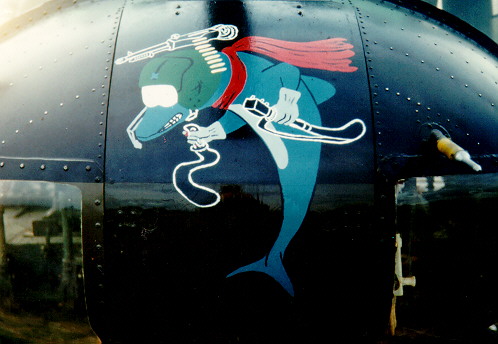



 there were a few individualized drawings used for nose-art on Dolphins, both before and after the ones depicted here, none were known to have been used on more than one aircraft at a time. The photo at the right was drawn on one of the Dolphins in early 1967, but was a one-only drawing (click HERE for more information on this photo). The logo that did become widely used depicted a caricature of a dolphin standing on its tail. It was drawn on the nose of the helicopter on the avionics door cover, with teeth showing, wearing a flight helmet, with a red scarf around its neck. (Note: Later a red scarf was used to indicate Dolphins from the 2nd Flight Platoon and a yellow scarf was used to indicate 1st Flight Platoon.) An M-60 machine-gun was on top of the helmet. The dolphin had arms, and in its right gloved hand it was holding a cyclic. In the left hand it held a collective. Those were the normal flight controls held by the pilots while flying.
there were a few individualized drawings used for nose-art on Dolphins, both before and after the ones depicted here, none were known to have been used on more than one aircraft at a time. The photo at the right was drawn on one of the Dolphins in early 1967, but was a one-only drawing (click HERE for more information on this photo). The logo that did become widely used depicted a caricature of a dolphin standing on its tail. It was drawn on the nose of the helicopter on the avionics door cover, with teeth showing, wearing a flight helmet, with a red scarf around its neck. (Note: Later a red scarf was used to indicate Dolphins from the 2nd Flight Platoon and a yellow scarf was used to indicate 1st Flight Platoon.) An M-60 machine-gun was on top of the helmet. The dolphin had arms, and in its right gloved hand it was holding a cyclic. In the left hand it held a collective. Those were the normal flight controls held by the pilots while flying. The top photo and the photo to the left show the original nose-art of this type, designed and painted on Dolphin 66-16235 by WO1 Richard Machina in July or August 1967. Dolphin 235 was a brand new UH-1D that had just arrived in the Company, and four of the first five photos (with the exception of the early '67 photo) are of the same aircraft.
The top photo and the photo to the left show the original nose-art of this type, designed and painted on Dolphin 66-16235 by WO1 Richard Machina in July or August 1967. Dolphin 235 was a brand new UH-1D that had just arrived in the Company, and four of the first five photos (with the exception of the early '67 photo) are of the same aircraft. last flight as a "peter pilot" (co-pilot), before he too became an aircraft commander. Both McDaniel and Machina had passed their Aircraft Commander checkrides the day before this flight. While at about only 50 feet altitude on approach to an LZ "way out in the boonies," the helicopter took multiple hits in the fuselage and cockpit area from automatic weapons fire when it flew directly over the VC while on short final. Several armor-piercing rounds went completely through the aircraft body, including the fuel cells, exiting through the top of the aircraft. One round went through the windshield only inches from Machina. He was hit by another armor-piercing round that entered through the aircraft belly directly below his legs. The 3nd, 4rd, and 5th photos were taken of his aircraft soon after Machina was dropped off at the Chu Lai hospital medevac pad. Machina's design was copied and many of the later Dolphin helicopters had variations of this same caricature painted on them by other people, usually crew chiefs and gunners.
last flight as a "peter pilot" (co-pilot), before he too became an aircraft commander. Both McDaniel and Machina had passed their Aircraft Commander checkrides the day before this flight. While at about only 50 feet altitude on approach to an LZ "way out in the boonies," the helicopter took multiple hits in the fuselage and cockpit area from automatic weapons fire when it flew directly over the VC while on short final. Several armor-piercing rounds went completely through the aircraft body, including the fuel cells, exiting through the top of the aircraft. One round went through the windshield only inches from Machina. He was hit by another armor-piercing round that entered through the aircraft belly directly below his legs. The 3nd, 4rd, and 5th photos were taken of his aircraft soon after Machina was dropped off at the Chu Lai hospital medevac pad. Machina's design was copied and many of the later Dolphin helicopters had variations of this same caricature painted on them by other people, usually crew chiefs and gunners. Dolphin's nose-art varied greatly, but all maintained the same basic look and theme. This particular helicopter crashed within a month or so after Machina was medivaced, when another pilot had a tail rotor strike resupplying a rocky hilltop observation post at night in a rain storm, causing the tail rotor to depart the rest of the aircraft. After the tail rotor failed, the helicopter began to spin out of control on the rocky hilltop until the main rotor also contacted a boulder, causing it to separate from the aircraft as well. Minus both its rotors, the helicopter then rolled partially down the hill. The aircraft was destroyed, but the nose avionics door cover (with the nose art) was saved. (Click HERE to see a photo of Dolphin after the crash.)
Dolphin's nose-art varied greatly, but all maintained the same basic look and theme. This particular helicopter crashed within a month or so after Machina was medivaced, when another pilot had a tail rotor strike resupplying a rocky hilltop observation post at night in a rain storm, causing the tail rotor to depart the rest of the aircraft. After the tail rotor failed, the helicopter began to spin out of control on the rocky hilltop until the main rotor also contacted a boulder, causing it to separate from the aircraft as well. Minus both its rotors, the helicopter then rolled partially down the hill. The aircraft was destroyed, but the nose avionics door cover (with the nose art) was saved. (Click HERE to see a photo of Dolphin after the crash.) Jim... You asked if anyone had info about the demise of Dolphin nose art, to drop you a line.
To the best of my knowledge, the nose art was standard thruout 1968, and most of the
helicopters had it painted on them. In November 1968, I was DEROS-shuffled to Duc-Pho
from the 176th (Chu-Lai). (Webmaster's note: DEROS = Date of Estimated Rotation [or Return]
OverSeas.) Others came to Duc-Pho with me, and Maj Brown talked some of
us into extending. We were all very near the end of our tours at the time. I extended, and as I
had been in the 2nd Plt of the 176th, he assigned me to 1st Plt of the 174th. A few of the
174th helicopters did not have nose art, and I ended up with one of them. There was a guy
that worked in the engine shop (tent) doing Hot End inspections. He had a few spare nose
doors in there, and painted the Dolphin nose art on them, and in turn, sold them to the
Crew Chiefs. He then got their old nose door when they replaced it with their new acquisition.
Early in 1969, he must have DEROS'ed (returned Stateside), as the art studio just went away. I did a little bit of
art for the guys, but the flight schedule got severe and there was little time to do anything
but sleep. I recall doing intermediate inspections on the flight line every other night (that
was a 25-hour inspection, every other night). Crew Chiefs and Gunners flew on medical waivers
all the time. The paperwork was handled routinely between the Flight Surgeon and Operations so
we didnít even have to go in for the medical after our first time. With the resident artist
from 1968 apparently now DEROS'ed, and no one else in the Maintenance Plt. doing the work,
attrition just caused the nose art to fade away. Some of us painted names on the nose (that
was something anyway), but there was little enough time for that. I painted "Satan" on 463
(my helicopter), and we had to take off with the paint still wet. I was concerned it would
get smeared across the nose, but the paint held. About the time the Dolphin nose art began
to vanish, the Sharks found an artist somewhere, who had the time and materials to paint the
large art displays on the compartment doors just ahead of the tail boom. Perhaps each Shark
Crew Chief did his own art work, I donít know. As far as I know, no authority issued any
orders against the nose art. They did, however, put a stop to the painting of flight helmets
in very late 1969. Those of us in the first platoon were ordered to paint our helmet black,
or olive drab, but no other color, or art allowed. This was near the end of my tour then, as
I had extended a second time while at Duc-Pho (finally going home after two years and six days, in January
1970). I donít know about anything that happened before or after my tour with the 174th,
but what I have written here, is just how I remember it. Thanks for your time, and I hope
this helps answer your question. --Ben Kennedy, Dolphin Crew Chief Nov 1968 to Jan 1970.
Jim... You asked if anyone had info about the demise of Dolphin nose art, to drop you a line.
To the best of my knowledge, the nose art was standard thruout 1968, and most of the
helicopters had it painted on them. In November 1968, I was DEROS-shuffled to Duc-Pho
from the 176th (Chu-Lai). (Webmaster's note: DEROS = Date of Estimated Rotation [or Return]
OverSeas.) Others came to Duc-Pho with me, and Maj Brown talked some of
us into extending. We were all very near the end of our tours at the time. I extended, and as I
had been in the 2nd Plt of the 176th, he assigned me to 1st Plt of the 174th. A few of the
174th helicopters did not have nose art, and I ended up with one of them. There was a guy
that worked in the engine shop (tent) doing Hot End inspections. He had a few spare nose
doors in there, and painted the Dolphin nose art on them, and in turn, sold them to the
Crew Chiefs. He then got their old nose door when they replaced it with their new acquisition.
Early in 1969, he must have DEROS'ed (returned Stateside), as the art studio just went away. I did a little bit of
art for the guys, but the flight schedule got severe and there was little time to do anything
but sleep. I recall doing intermediate inspections on the flight line every other night (that
was a 25-hour inspection, every other night). Crew Chiefs and Gunners flew on medical waivers
all the time. The paperwork was handled routinely between the Flight Surgeon and Operations so
we didnít even have to go in for the medical after our first time. With the resident artist
from 1968 apparently now DEROS'ed, and no one else in the Maintenance Plt. doing the work,
attrition just caused the nose art to fade away. Some of us painted names on the nose (that
was something anyway), but there was little enough time for that. I painted "Satan" on 463
(my helicopter), and we had to take off with the paint still wet. I was concerned it would
get smeared across the nose, but the paint held. About the time the Dolphin nose art began
to vanish, the Sharks found an artist somewhere, who had the time and materials to paint the
large art displays on the compartment doors just ahead of the tail boom. Perhaps each Shark
Crew Chief did his own art work, I donít know. As far as I know, no authority issued any
orders against the nose art. They did, however, put a stop to the painting of flight helmets
in very late 1969. Those of us in the first platoon were ordered to paint our helmet black,
or olive drab, but no other color, or art allowed. This was near the end of my tour then, as
I had extended a second time while at Duc-Pho (finally going home after two years and six days, in January
1970). I donít know about anything that happened before or after my tour with the 174th,
but what I have written here, is just how I remember it. Thanks for your time, and I hope
this helps answer your question. --Ben Kennedy, Dolphin Crew Chief Nov 1968 to Jan 1970.